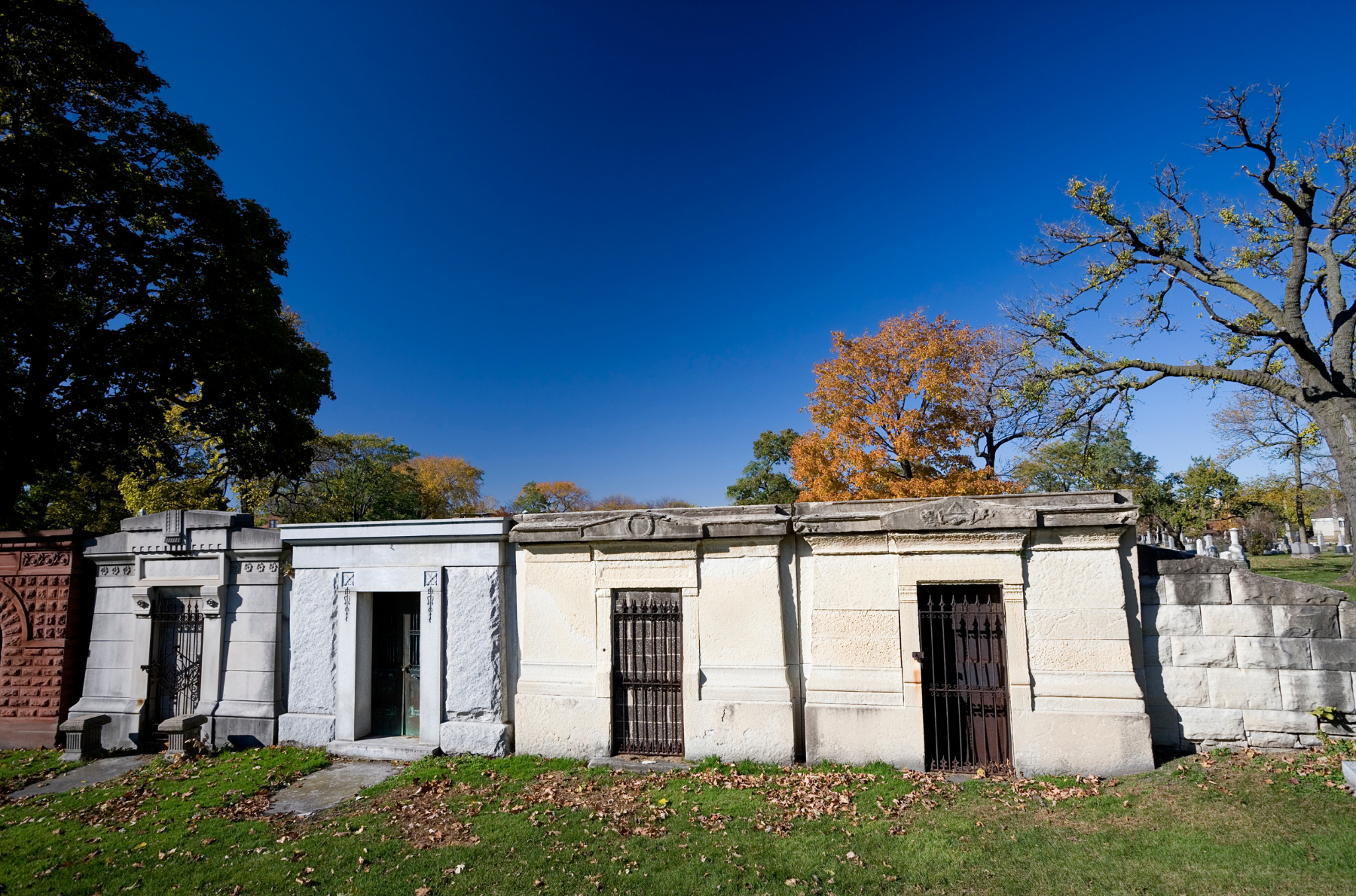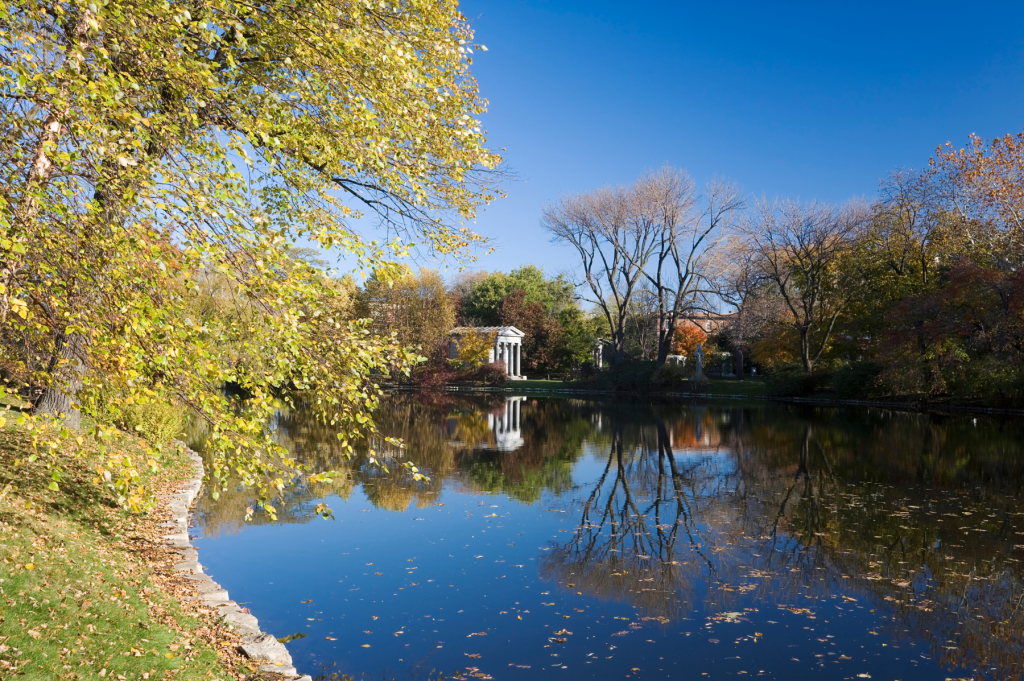
Graceland Cemetery: Where Chicago Legends Are Buried
Published on October 19, 2023
One of eATLAS’ newest adventures is The Deep Pockets of Graceland Cemetery, a 90-minute exploration of the gravesites of the famous Chicagoans buried on the grounds. The tour was created by Ronnie Frey of the popular Doorways of Chicago Instagram feed.
By Dave Lifton (@daveeatschicago)
Walking through Graceland Cemetery is a lesson in Chicago history unto itself. Located at the intersection of Irving Park Rd. and Clark St. in Uptown, many of its tombstones, monuments, and mausoleums bear the names of the movers and shakers who helped the Windy City morph from a swampy Midwestern outpost into one of the world’s great cities, including:
- Architects: Daniel Burnham and his partner John Wellborn Root, Louis Henri Sullivan, William Le Baron Jenney, William Holabird, Ludwig Mies van der Rohe, Marion Mahony Griffin, and Sears Tower co-designers Bruce Graham and Fazlur Khan
- Chicago Mayors: Carter Harrison Sr. and Jr., Fred Busse, Hempstead Washburne
- Businesspeople: Marshall Field, Cyrus McCormick, Charles Wacker, George Pullman, Potter and Bertha Palmer, Joseph Medill, Phillip Armour, William Kimball
- Athletes: Ernie Banks, Jack Johnson
- Other notable Chicagoans: Roger Ebert, Daniel Hale Williams, John Peter Altgeld, John Kinzie, Augustus Dickens (brother of Charles)
The story of Graceland Cemetery begins in 1860, when a lawyer named Thomas Bryan led a group that included the city’s first mayor, William B. Ogden, that purchased 80 acres in rural Lake View Township, two miles north of Chicago’s then border of Fullerton Ave. (Lake View would be annexed by the city in 1889.) Bryan chose the location because it was set on a high ridge—thereby allowing for greater drainage—and on a former Indian trail called Green Bay Rd. (now Clark St.), which would make it accessible. The first burial was Bryan’s son, Daniel, who was interred on April 13, 1860. Shortly thereafter, Bryan hired William Saunders and a Swedish landscaper named Swain Nelson to develop the grounds.

Almost immediately, Graceland started receiving bodies from City Cemetery, which was located adjacent to Lake Michigan. But questions about the health risks associated with putting corpses so close to Chicago’s source of drinking water caused the city to remove the bodies. By 1873, approximately 2,000 people were re-interred at Graceland, and City Cemetery became Lincoln Park, which, coincidentally, was also laid out by Nelson.
In the 1870s, Horace W.S. Cleveland and William Le Barron Jenney were brought in to lead the next era of the cemetery. During this decade, the park-like atmosphere for which Graceland is famous—the curved paths, lakes (only Lake Willowmere remains), and open spaces—began to take shape.
Graceland Cemetery had acquired another 39 acres in 1879. Jenney, whose 10-story Home Insurance Building would be considered the world’s first skyscraper upon its completion in 1885, recruited one of his proteges, Ossian Simonds, to work on the new section. As superintendent of the grounds from 1880-1897, Simonds would become the landscape architect most closely associated with Graceland. His most famous contribution was adding plant life native to the region, and arranged in a manner to suggest that the layout evolved naturally. This approach would become influential on the burgeoning Prairie School that would revolutionize American architecture.
For all its elegance and wealth contained within, Graceland wouldn’t be a proper cemetery if it didn’t also have a ghost story. In 1880, a six-year-old girl named Inez Clarke was struck by lightning and killed. Her gravesite is adorned by a statue that is covered by glass to protect it from the elements. The legend states that, during thunderstorms, the sculpture disappears. For decades, the story was even more ghoulish because there is no record of anybody named Inez Clarke buried in the cemetery. However, Adam Selzer of Mysterious Chicago dug deep into the mystery and discovered that Inez’s proper last name was Briggs from her mother’s first marriage.
Another macabre element at Graceland is The Eternal Silence, a 1909 sculpture by Lorado Taft. The Grim Reaper-like statue stands eight feet tall, is made of bronze, and is set against black granite. He marks the final resting place of Dexter Graves, one of the earliest White settlers in Chicago. Taft created a second piece at the cemetery called The Crusader, a 10-foot medieval knight at the gravesite of Chicago Daily News publisher Victor Lawson.
Although a cemetery wouldn’t seem to be a place for visitors to Chicago to explore, Graceland Cemetery’s combination of local history in a beautiful, pastoral setting make it an ideal tourist destination.

The Adventure starts when you say it does.
All eATLAS Adventures are designed and built by experienced eATLAS Whoa!Guides. They're always on. Always entertaining. And always ready to go.
Check out our Adventures!